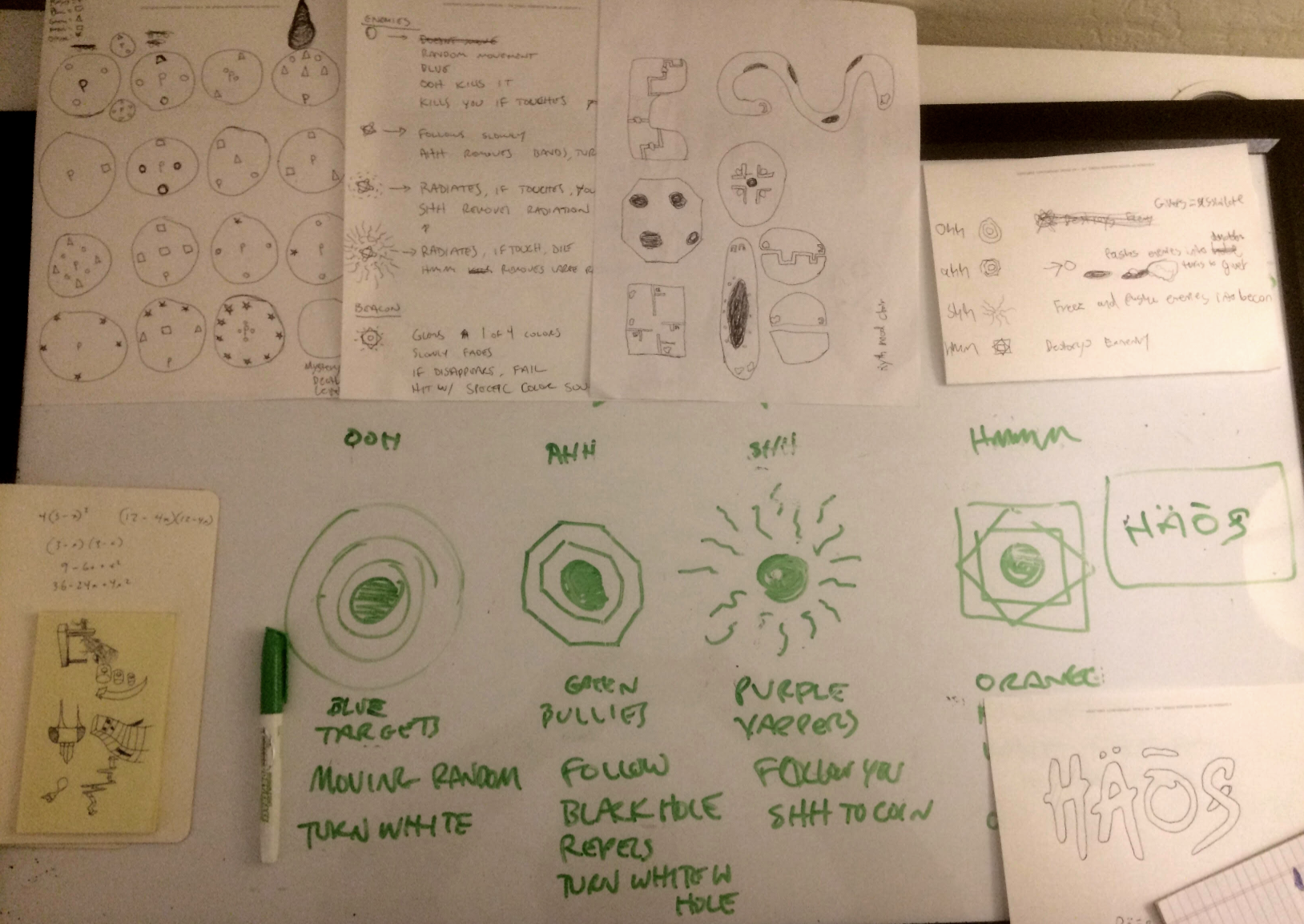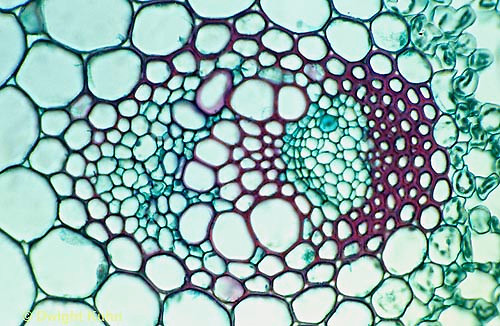 AN ADDICTIVE
AN ADDICTIVE
CYBER-CELLULAR
COSMIC PETRI-DISH
SOUND-WAVE BLASTING
ACTION ART GAMEPlay the demo in browser or download for Windows / OS X here:
https://thelucre.itch.io/haos

Global Game Jam 2017 just closed and this DevLog is going to cover the initial build and next steps. In 48 hours, my team of 3 members created what I consider a super balanced combination of trippy art game and mechanical action. This surprised us. Once we started adding SFX and "juice" it came together so well that we knew we'd hit something special.
The GGJ presentation went really well and the HAOS demo made a distinct impression on the jammer audience. We've taken it to a few other groups since and gamers, artists, non-gamers, and general lookie-lous have been drawn to people playing it. This reaction (my own gut and the unsolicited reaction from others) has convinced me to consider elaborating on the project.
The GGJ demo has 20 levels and takes about 20-40 minutes to beat, depending on the skill/strategy level of a given player. The goal moving forward is to build a fully featured game from the existing engine, to increase social playing and hardcore completionists. Immediate features on the list include co-op and competitive horde modes (up to 4 players), time attack and speed run leaderboards, and an extensive level stack (at least 100), potentially with difficulty lanes (normal, medium, extreme). Because the game can be almost meditative and the controls are dead simple, I want casual players to be able to soak up the vibe in the normal mode, while giving serious players a chance to test their mettle. The difficulty and strategy of each level plays out in a fascinating way, that simply adding and rearranging enemies creates drastically different challenges.
Anyway, enough of the forward pitch. Here are the details of the original build for the game jam:
Ideation and Concept The theme for GGJ was
waves, so we naturally chose three possible lanes: water waves, sound waves, and wave gestures. Water seemed to literal, and waving seemed a little kitschy (though some of the waving games we played after were done super well!). We chose sound because we've been wanting to make an aural-forward game for awhile now. From the very first concepting, it was understood that sound waves would be the weapon/defense and more importantly, each attack would have a corresponding color and "voice". We settled on sounds that seem totally unaggressive: Ooh, Ahh, Shh, Hmm.

The image above is all of our notes. We considered having more distinct environmental designs (walls, mazes, traps, switches, all the tropes of an action/adventure game. You can see at the top center of the note image that we toyed with, which felt forced and stereotypical. There was a conscious effort to pare down the environment (in the interest of time and in purity of design). The end result was a single screen level that felt almost like a port hole into the game world. This significantly reduced our level design options, which turned out to be the best idea we had during the jam.
MechanicsAfter committing to a single screen design, we went into mechanics. It seemed obvious to have a player who moved around with simple analog stick controls (we're console lovers). The first enemy pass was a tiered system, with four tiers, where the player would have to use the corresponding color to whittle down the enemy until they could be defeated. This quickly seemed to minimize the dynamics of our game, so we moved towards a more individualized enemies: each had their own size, color, behavior, and effectively, attitude.
Blue (bystanders) - These lil guys rummaged around, with no specific objective. They are purely obstacles.
Green (bullies) - These foes lock onto the player and follow them around constantly. A green Ahh soundwave can push them back and shrink their size until they are destroyed. They also have bouncing physics which gets interesting when they're hit by orange killers.
Pink (yappers) - The yappers halt first, then emit an eerie Heyyyy, then slowly move toward the player, in a repeating pattern.
Orange (killers) - These lil comets fire directly at a player's position (at a given point in time) until they hit the walls of the cell, then pause and repeat. This gets really interesting when it pushes other bad guys around the cells, creating auxiliary chäōs.
Aesthetic & Design ConsiderationsIt was almost too simple. But once we got it working, it made perfect sense. The port was animated to open and close, signifying either a player death or a win. This allowed us to free up the entire scene during that wiping transition. Because it was so tidy, the levels were built as Unity3D prefabs, and the game controller / main camera / level boundaries were globally available. This let us build levels extremely fast (because it's basically just enemy prefabs, the player object, and enemy (X,Y) positioning, and load those prefabs into an array on the game controller. This controller either incremented the level index on a win or did not on a fail, closed the port hole, destroyed the entire level prefab that's currently loaded, and instantiated a new one.
This design conceit did two amazing things: it seriously improved our time-to-play for level design (just drop a few enemies on a prefab, add a LoadableScript component, and stick it into the Game controllers array. It also turned out to be a very elegant way to clear the level, keep the trippiness of the design and make the entire death/replay cycle extremely short. Just short enough for you to catch a breath and think about what went wrong if you failed. This rapid feedback loop, with zero HUD, options, or checkpointing drastically lowers the barrier to keep playing for the user. In all our play testing, people did not willfully stop playing unless they ran out of time or beat the demo.
Sound had a big presence for this game and there were a few tricks we used to make keep it cohesive in-game. First, the ambient music is subtle, eerie, and relaxing. This combination is fascinating in the same way that HAOS is tense and meditative in equal parts. Special care was given to keep synthesized sound effects in the same key as the BGM track, so whenever they're triggered, they play well regardless of timing. The vocal SFX were chosen for two reasons: to anthropomorphize the player and enemies, as well as increase the soothingness of the entire game. We chose specifically to keep all SFX soft so the player wouldn't be overwhelmed with sound (especially bad in a game that was designed around sound!)

The color palette began as a challenge. It was originally a flat, muted palette. I was particularly inspired by microscopic plant cell images and wanted to recreate that look and feel. After playing with options, it became clear that the level BG had to be dark and the "cell" walls should be contrasting. We ended up with very neon colors that popped (especially with a bloom shader). In the end our geometry was still inspired by organic cell shapes, but the palette was cosmic, spacey, and bold. This combination of micro- and macroscopic played perfectly with our of a psychedelic game, with a fractal nature of minuscule imagery that can also reflect the cosmos.
A final note on "juice." We added what are now all standard action effects: screen shake (diminishing), particle death animations (to make it look like the organelles burst), a few effect shaders (bloom, chromatic aberration), SFX for many subtle interactions and feedback (when the player charges fully, they oscillate color and emit a soft tone), and also some original effects. The cell walls seem to undulate but it's just a liquefied (photoshop terminology) circle that spins slowly. A big effort was made to keep all environment and enemies as organic shapes. The contrasting sound waves, which appear as mathematical and sharp, set apart the attack animations from the entities on screen (which are the same color). Moving bodies also exhibit a little squish based on their velocity (simple X/Y scaling) to make them feel more organic.
Lastly, the controls. We designed the sound blasts to be spammable, but quickly found that the player could wipe out an entire room with ease and the gravitas of the Ohh/Ahh/Shh/Hmm was lost in the repetitive noise. We decided to force the player to charge their attack which changed the mechanics in a couple interesting ways. The player had to make an opportunity cost between committing to a charge color when they might be threatened by more than one enemy type. The charge would also slow the player down so being alert and ready would cost precious speed when the action intensified.
Going forwardWe learned a lot during this year's GGJ. First, a simple (I mean dead simple) game from a technical perspective can still be a fascinating, accessible, and inspiring game when solid mechanics meet artistic presentation. Second, we've all heard that limitations foster creativity, but in this case, self-imposing limitations purposefully (beyond the jam timeline and theme) created a much more interesting game. Third, having a strong artistic perspective (ours was weirdness, trippiness, sound-first design, and organic/cosmic visual influence) makes all creative decisions later so much easier. Whatever the lean is, that focal point (however abstract/loose) should be respected. It creates a foundation for all later decisions (and every game has SO many decisions to make during production) that makes the entire product feel like a holistically realized thing. Whoa...man *far off stare...slow smile*
Ok enough for now. The reception has stimulated us into pushing this game forward. It will be Steam Greenlight voteable soon and I'll be back to post the feature roadmap and any other interesting bits. If you made it this far and haven't played the game yet *pat on the back, friend* and check it out! Any/all criticism is welcome (sincerely) and thank you so much for reading. Stay tuned.
- Eric, Lucre Games
@theLucrePlay the HÄŌS demo for Windows / OS X here:
https://thelucre.itch.io/haos Community
Community DevLogs
DevLogs [Demo] HÄŌS - Psychedelic meditative action
[Demo] HÄŌS - Psychedelic meditative action Community
Community DevLogs
DevLogs [Demo] HÄŌS - Psychedelic meditative action
[Demo] HÄŌS - Psychedelic meditative action
